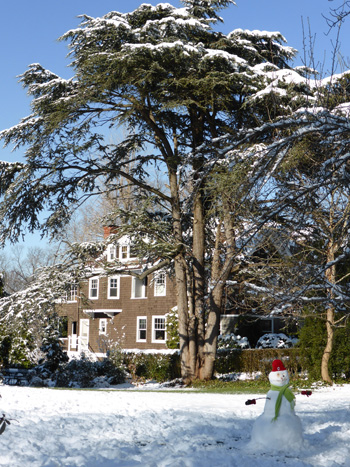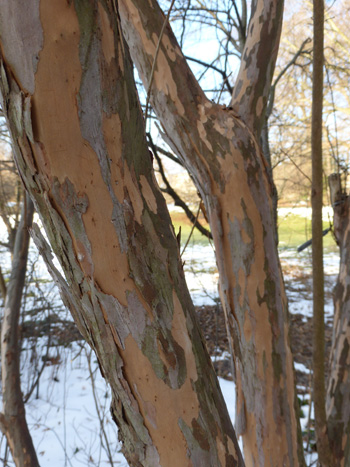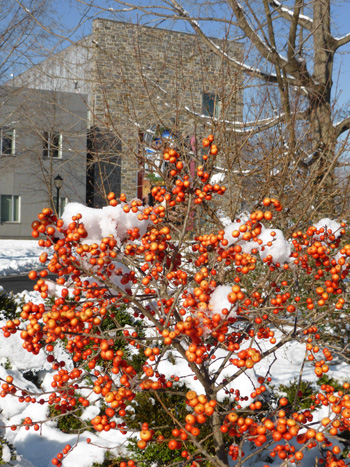Plants of the Week: December 16
 A mature blue atlas cedar, lightly top-dressed with snow, is a glorious sight. Native to the Atlas Mountains of Northern Africa, Cedrus atlantica grows 40’ to 60’ tall; however, heights of up to 120’ have been documented. Young trees are loosely pyramidal, becoming wide and flat-topped with age. Needle color ranges from varying shades of green to silvery blue. The Missouri Botanical Garden’s website explains the terminology of Glauca Group: “Glauca Group attempts to deal with this variety in needle color by lumping all of the various blue-needled plants into one group. Prior designations such as C. atlantica ‘Glauca’ and C. atlantica f. glauca have been eliminated in favor of C. atlantica (Glauca Group). Cultivar names for plants with uniquely different form are retained in the nomenclature…” Photo credit: J. Coceano
A mature blue atlas cedar, lightly top-dressed with snow, is a glorious sight. Native to the Atlas Mountains of Northern Africa, Cedrus atlantica grows 40’ to 60’ tall; however, heights of up to 120’ have been documented. Young trees are loosely pyramidal, becoming wide and flat-topped with age. Needle color ranges from varying shades of green to silvery blue. The Missouri Botanical Garden’s website explains the terminology of Glauca Group: “Glauca Group attempts to deal with this variety in needle color by lumping all of the various blue-needled plants into one group. Prior designations such as C. atlantica ‘Glauca’ and C. atlantica f. glauca have been eliminated in favor of C. atlantica (Glauca Group). Cultivar names for plants with uniquely different form are retained in the nomenclature…” Photo credit: J. Coceano
Garden Locations: Entrance Garden, Nason Garden, Walnut Lane
 Clethra barbinervis may just look its best in the winter. Persisting seed pods and exfoliating bark draw one’s eye to the deciduous shrub. Japanese clethra is regarded as an attractive, trouble-free, four-season shrub with clean foliage, fragrant summer bloom, good fall color, and spectacular bark. Like Clethra alnifolia, C. barbinervis attracts numerous pollinators; however the large shrub/small tree is taller in height and less fragrant. A must for every garden. Photo credit: J. Coceano
Clethra barbinervis may just look its best in the winter. Persisting seed pods and exfoliating bark draw one’s eye to the deciduous shrub. Japanese clethra is regarded as an attractive, trouble-free, four-season shrub with clean foliage, fragrant summer bloom, good fall color, and spectacular bark. Like Clethra alnifolia, C. barbinervis attracts numerous pollinators; however the large shrub/small tree is taller in height and less fragrant. A must for every garden. Photo credit: J. Coceano
Garden Locations: Cherry Border along Cedar Lane and The Fragrance Garden
 Ilex verticillata are always popular shrubs during the winter months, their bright berries adding color to an otherwise somber landscape. One cultivar drawing attention this season is I. verticillata ‘Sunsplash’. Hard orange-red berries afford longevity in the landscape as hungry birds prefer to eat other softer fruit first. Planting a male cultivar such as ‘Jim Dandy’ is necessary for fruit set. Photo credit: J. Coceano
Ilex verticillata are always popular shrubs during the winter months, their bright berries adding color to an otherwise somber landscape. One cultivar drawing attention this season is I. verticillata ‘Sunsplash’. Hard orange-red berries afford longevity in the landscape as hungry birds prefer to eat other softer fruit first. Planting a male cultivar such as ‘Jim Dandy’ is necessary for fruit set. Photo credit: J. Coceano
Garden Location: Near path along west side of Beardsley Hall





No Comments